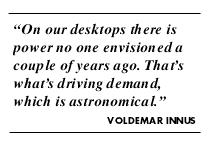
 Information technology is an essential ingredient in UB's ability to
attract and educate students, and the need to continue to embrace this
technology, despite its complexity and regardless of budget cuts, is
vital to the university's future.
Information technology is an essential ingredient in UB's ability to
attract and educate students, and the need to continue to embrace this
technology, despite its complexity and regardless of budget cuts, is
vital to the university's future. This is the message that Voldemar Innus, senior associate vice president for university services, has been taking recently to various campus groups in an effort to acquaint the university community with UB's computing needs and to keep them informed of plans to meet them.
Innus, who was appointed to lead UB's information technology efforts in August 1996, has developed an agenda, which he continues to refine, to assess the effectiveness of UB's IT capabilities, keep track of the state of IT globally and determine the directions in which UB needs to head.
"On our desktops there is power no one envisioned a couple of years ago. That's what's driving demand, which is astronomical," he said.
Expect the role of IT at UB to change rapidly and dramatically, Innus said, as global and university computing needs increase.
Key to UB's technological future is a move toward a three-tier, open-architecture, distributed client-server environment that uses the Internet/Intranet as a strategic tool. The plan is to build on, not discard, the university's current IT infrastructure, as well as to emphasize mainstream IT directions and operate as an "early follower."
The current demand for computing services "is actually much higher than the university has been able to accommodate," Innus said. "Most of our competitors have been outspending us in information technology and the gap is widening. We have to account for that and address it."
He noted that Northwestern University, which has a student population roughly half that of UB's, has 200 staff in centralized IT and another 200 staff working throughout the campus. "UB has half that....We've got some cause for concern," Innus said.
"We are underinvested significantly in technical staff. That has put a severe constraint on what we've been able to invest in information technology."
While the IT problems UB faces are not unique, they are critical in light of dramatic changes both in the delivery of education and in New York State funding, Innus said.
"In this environment of tension, we need to define, fairly quickly, centralized and decentralized responsibility," he said. "Information technology at UB is mission-critical and addressing information technology on this campus is very important."
For example, he noted, last year in the United States 700,000 students took some type of class that used distance learning. And the governors of 13 Western states have gotten together to offer classes through distance learning because of a projected 30 percent growth in college-bound students and lack of sufficient institutional space.
"The die has already been cast," Innus said.
"Other institutions with whom we want to be compared are already moving aggressively in the distance-learning direction," and UB needs to keep pace.
"Changes in New York State also are a catalyst for this emphasis. Students are demanding services in a way they never have before because they're paying the bill," Innus said.
UB needs to develop a comprehensive, multi-year IT plan that integrates academic IT needs, administrative IT needs and IT infrastructure needs.
Toward that end, the Information Technology Steering Committee has been formed. Its charge:
· Establish the vision and principles for the Information Technology Development Plan (ITDP).Chaired by Innus and reporting to the senior vice president, the committee consists of Nicolas Goodman, vice provost for undergraduate education; David Triggle, vice provost and dean of the Graduate School; Robert Palmer, vice president for Student Affairs; six deans representing the academic nodes; a Faculty Senate representative; Hinrich Martens, associate vice president for Computing and Information Technology (CIT); Barbara von Wahlde, associate vice president, University Libraries; Sean Sullivan, associate provost; Leonard Snyder, associate vice president and controller, and a yet-to-be-named professional staff representative.· Make recommendations regarding the scope and strategies for implementation of the ITDP.
· Set ITDP goals and priorities.
· Approve project plans, budgets, deliverables and schedules.
· Provide advice and guidance to the IT Coordination Committee.
In addition, an Information Technology Coordination Committee has been formed to structure and define projects; develop project plans, including budgets and schedules; provide project leadership; monitor budgets and schedules; report on project progress to the IT Steering Committee, and conduct process reviews, technical reviews and analyses.
Also chaired by Innus, the coordination committee includes Charles Dunn, director, CIT technical services; Dennis Henneman, director, CIT operational services; Susan Huston, director, CIT administrative computing; Charles Kaars, assistant vice president, Sponsored Programs; Richard Lesniak, director, CIT academic services; Elmira Mangum-Daniels, assistant provost; Martens; James Nadbrzuch, assistant vice president, Student Affairs; Carole Petro, associate vice president, University Services; Stephen Roberts, associate director, University Libraries; Louis Schmitt, director of administrative services, University Facilities; Edward Schneider, vice president for finance, UB Foundation; Kevin Seitz, assistant vice president, University Services; Snyder; Sullivan; von Wahlde; six staff representatives from the academic nodes and a representative of the Departmental Computing Consultants (DCC) Committee.
Communication is vital to UB's IT goals, Innus said, and regular meetings will be held with deans and associate/assistant deans, the Faculty and Professional Staff senates, administrative groups and departmental computing consultants, and student governments.
Feedback from throughout the university community also is important. Innus said he plans to establish faculty, staff and student focus groups, and to encourage the flow of information by developing a web site for information technology that includes all planning and implementation documents and provides an e-mail address to which comments can be sent.